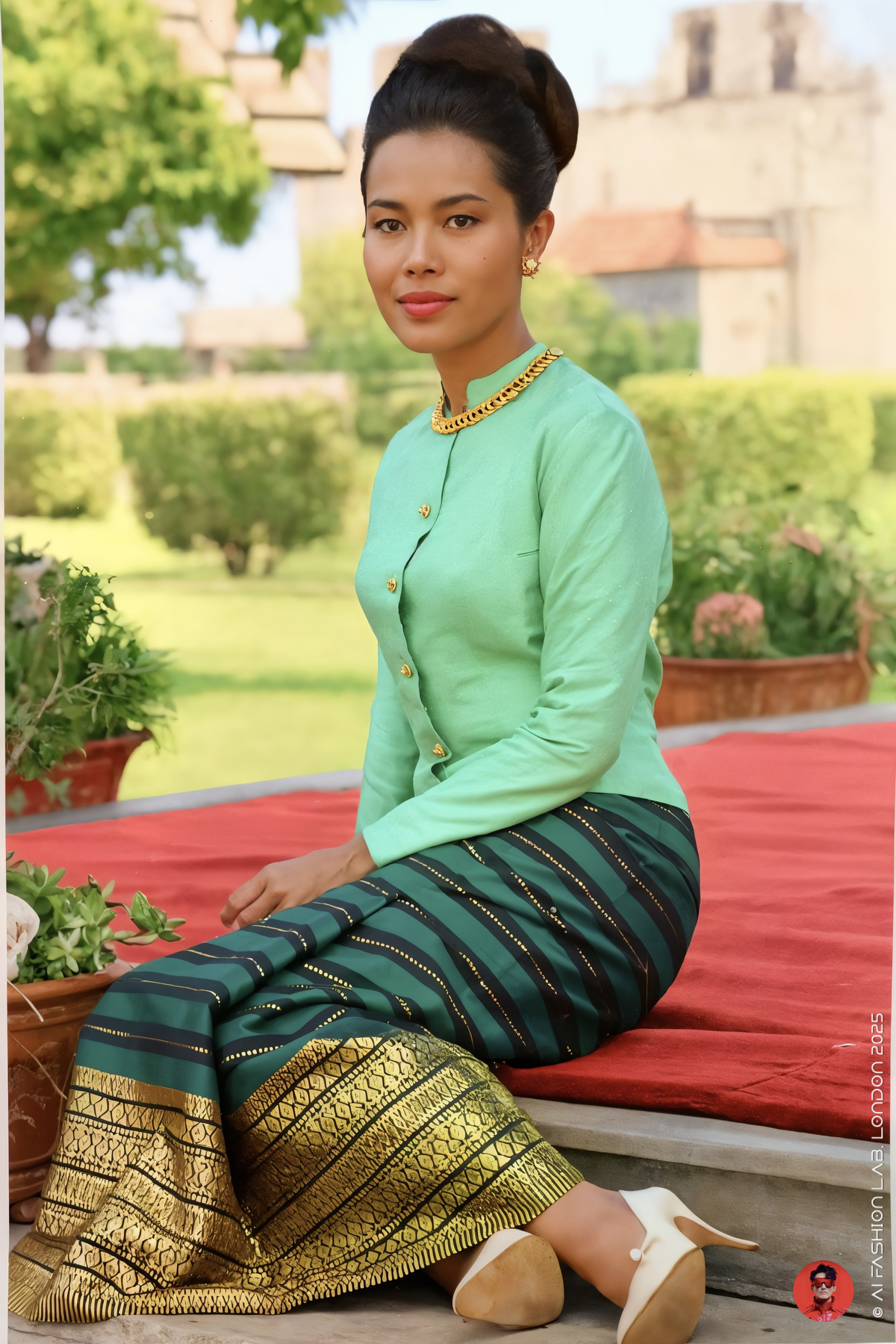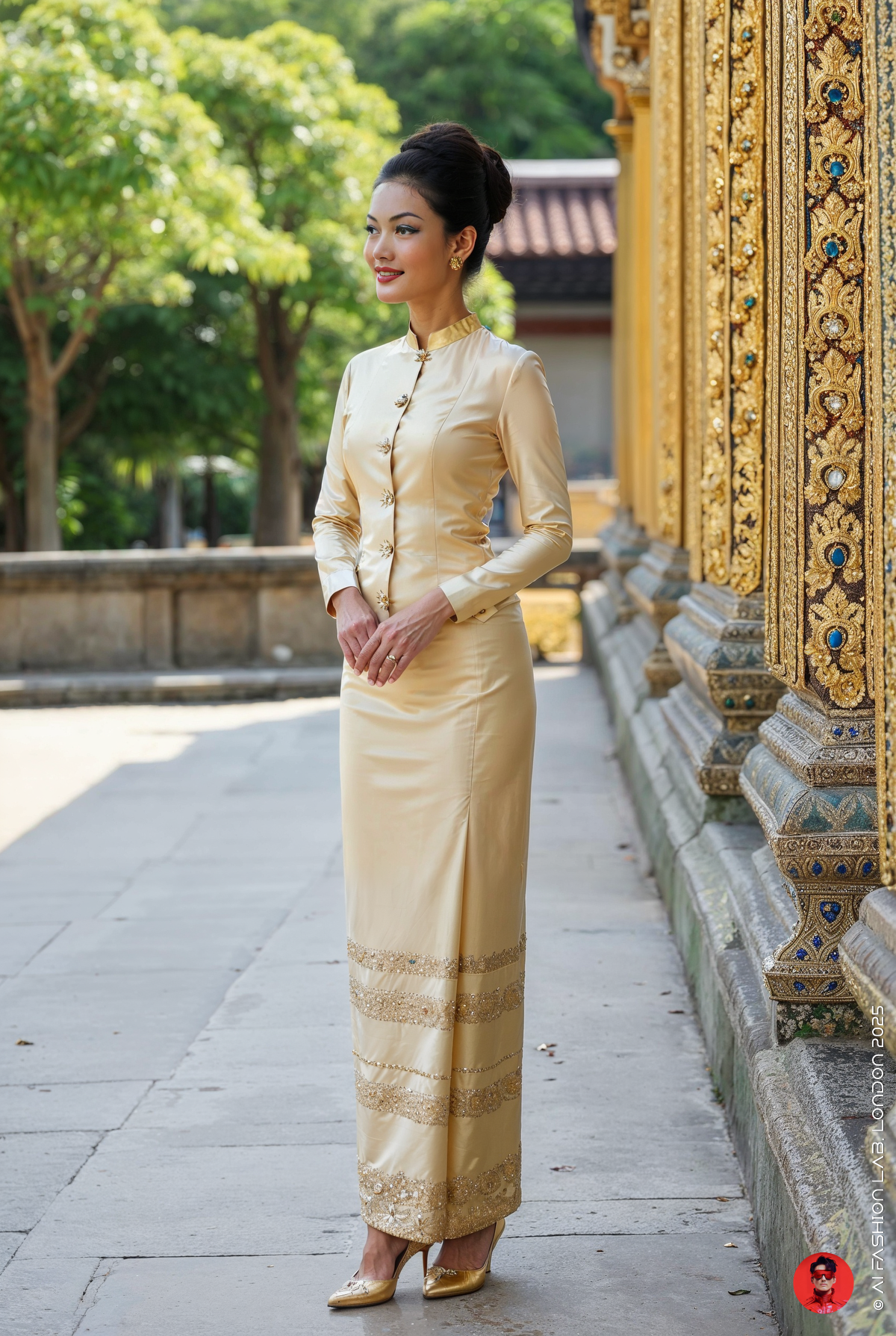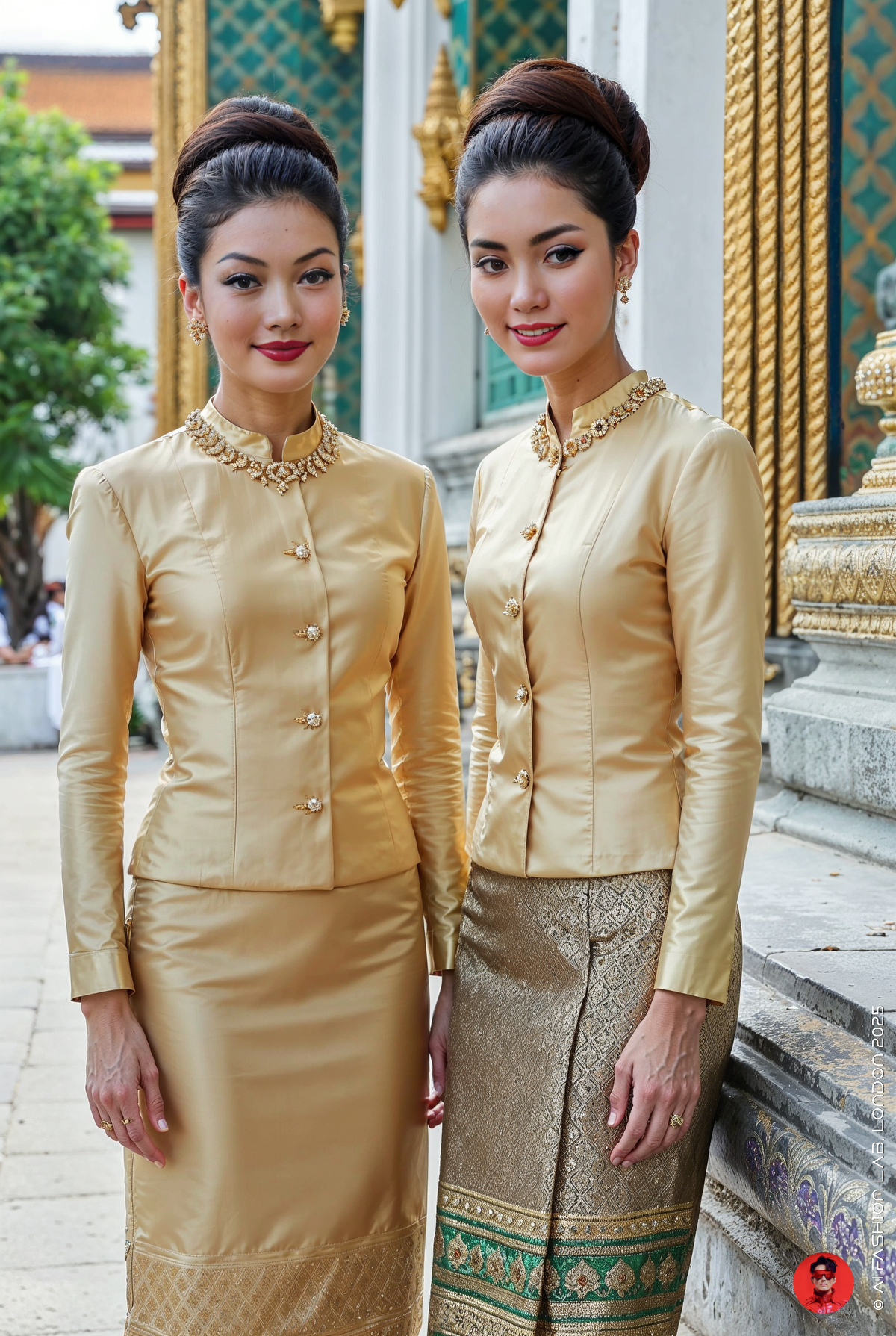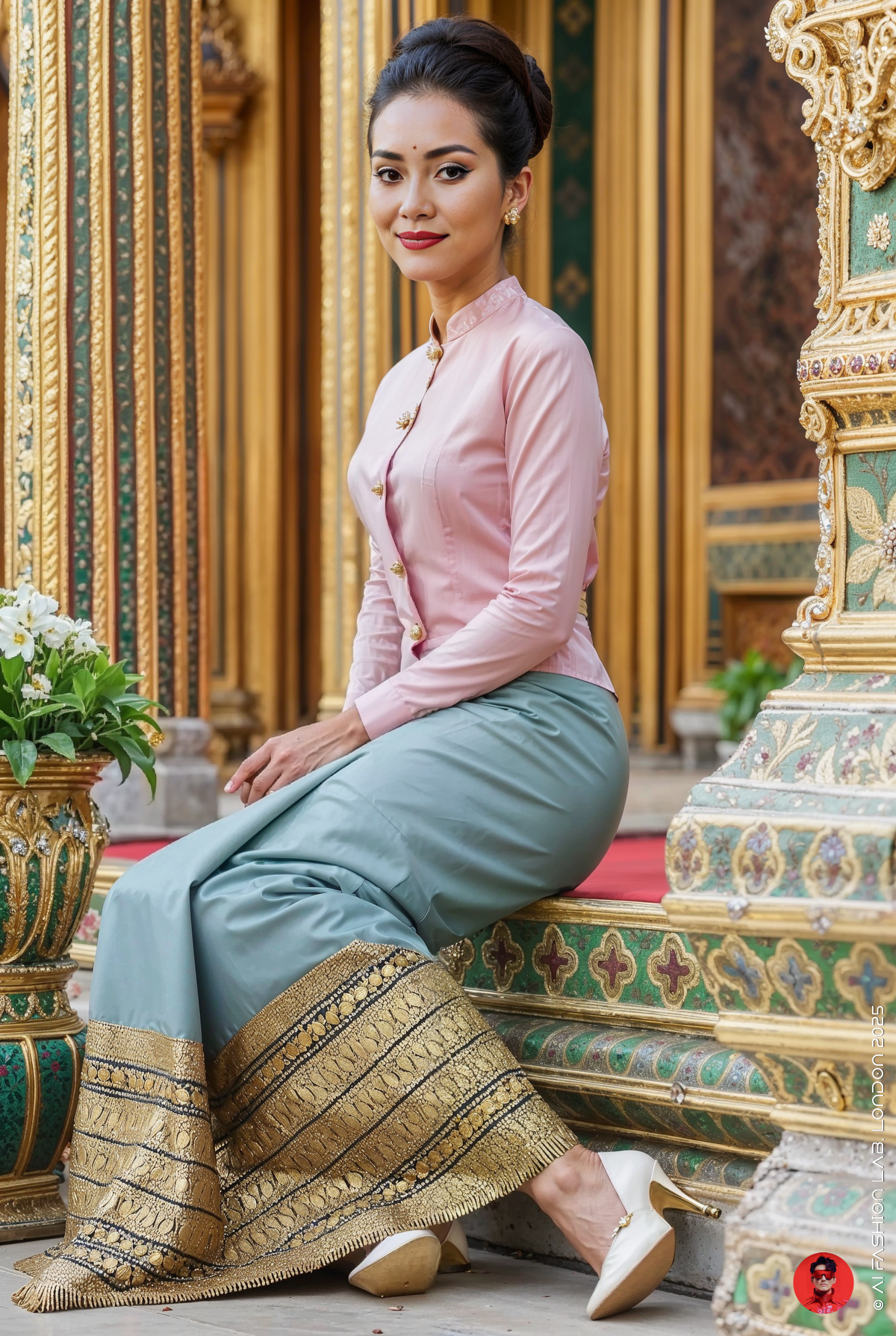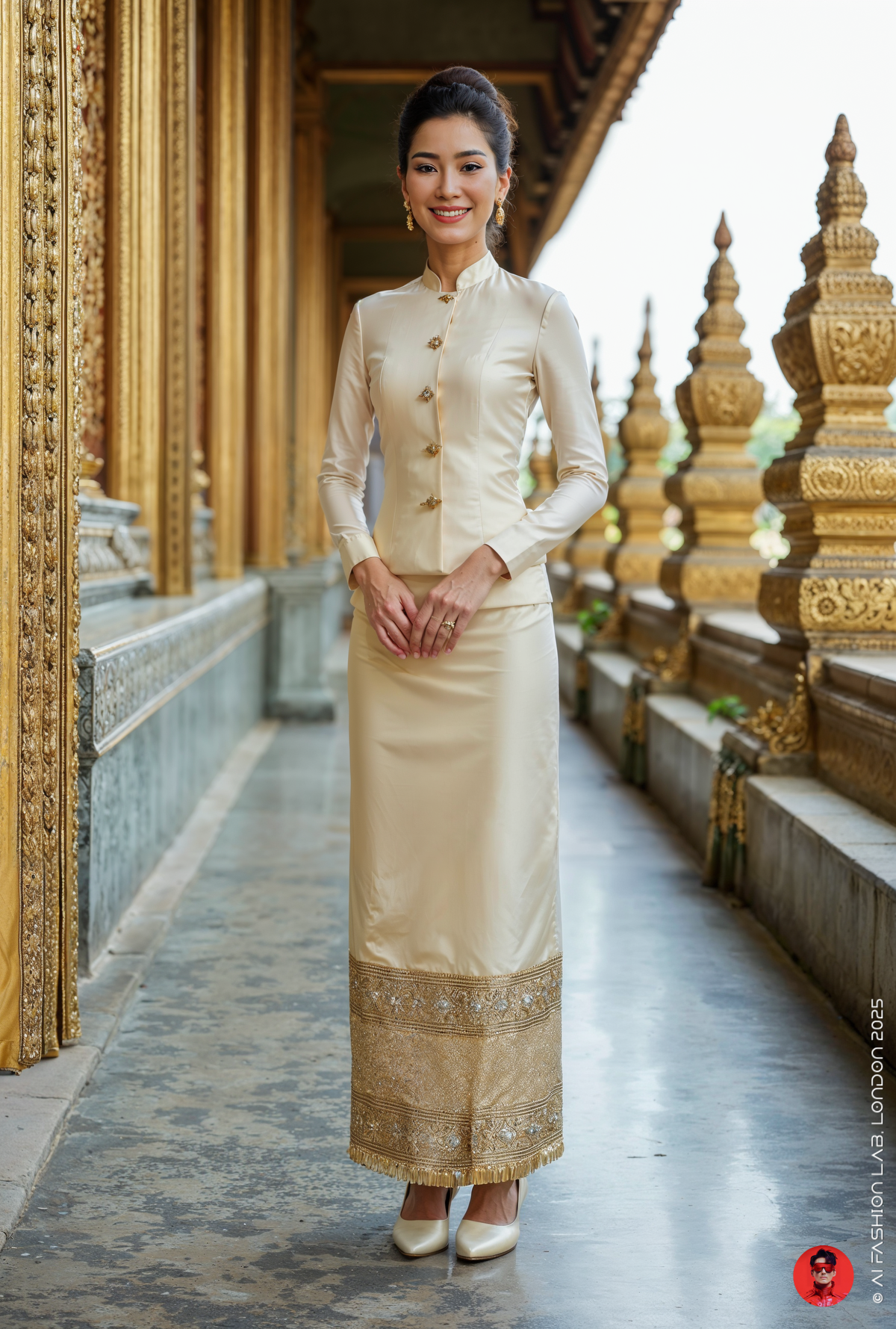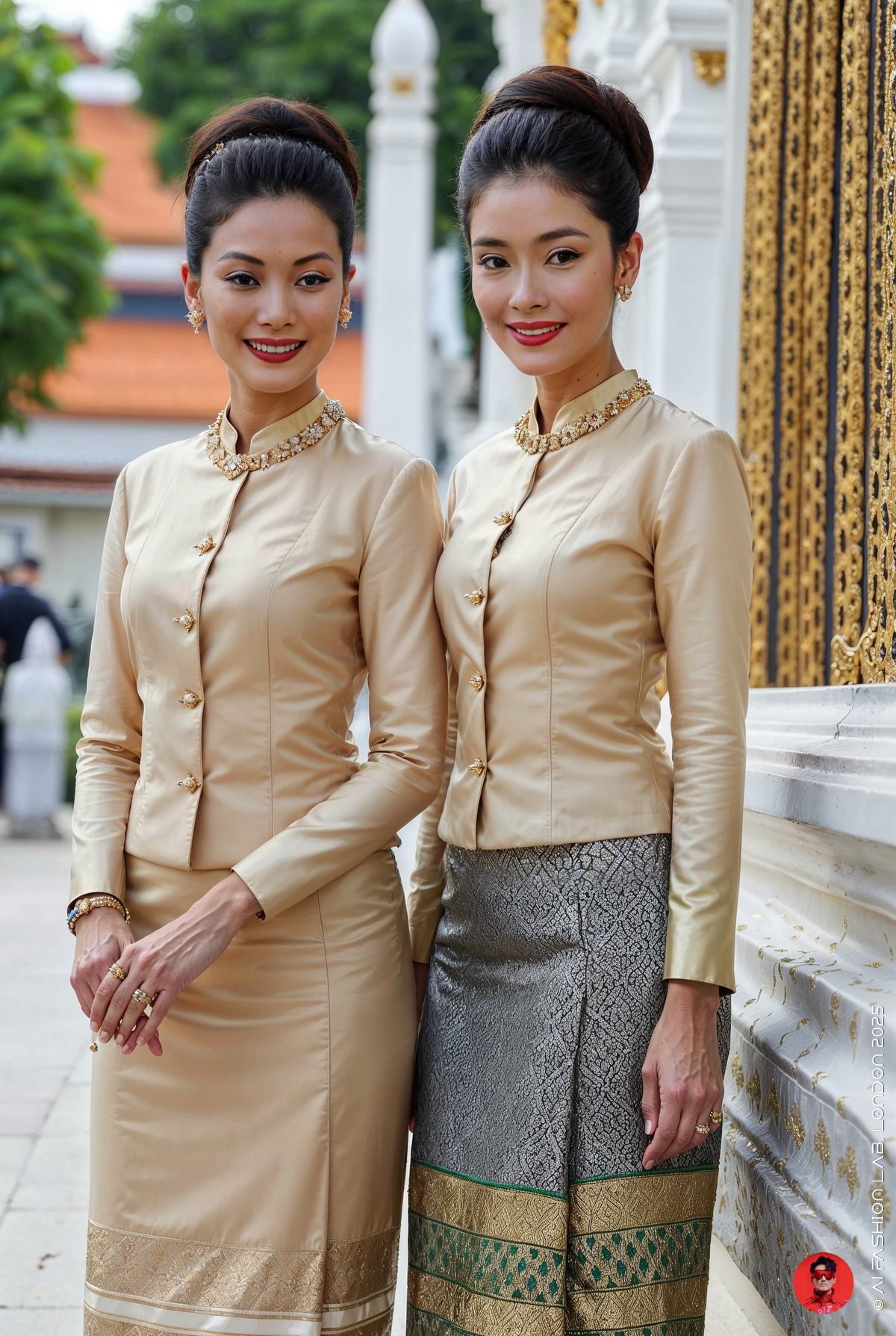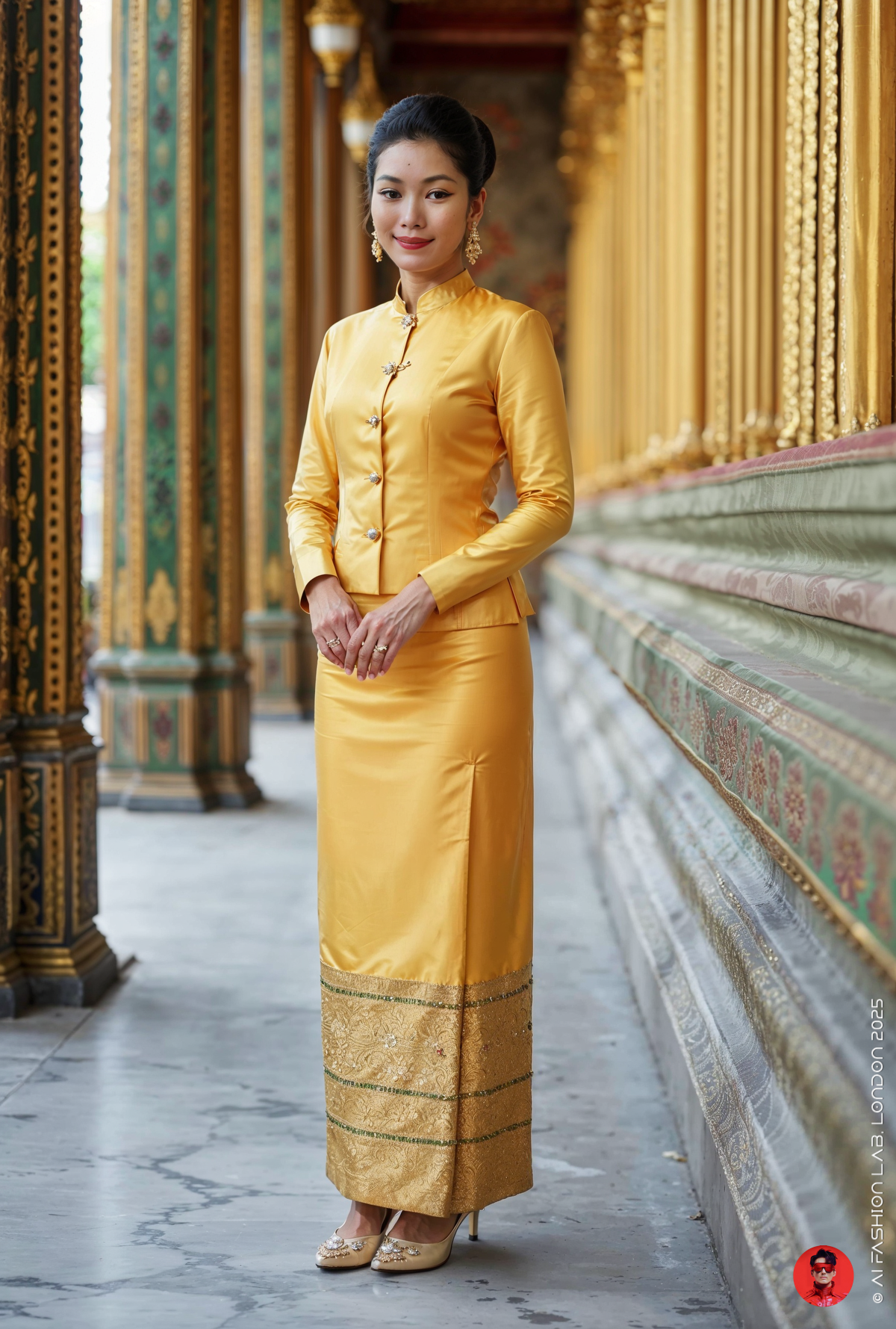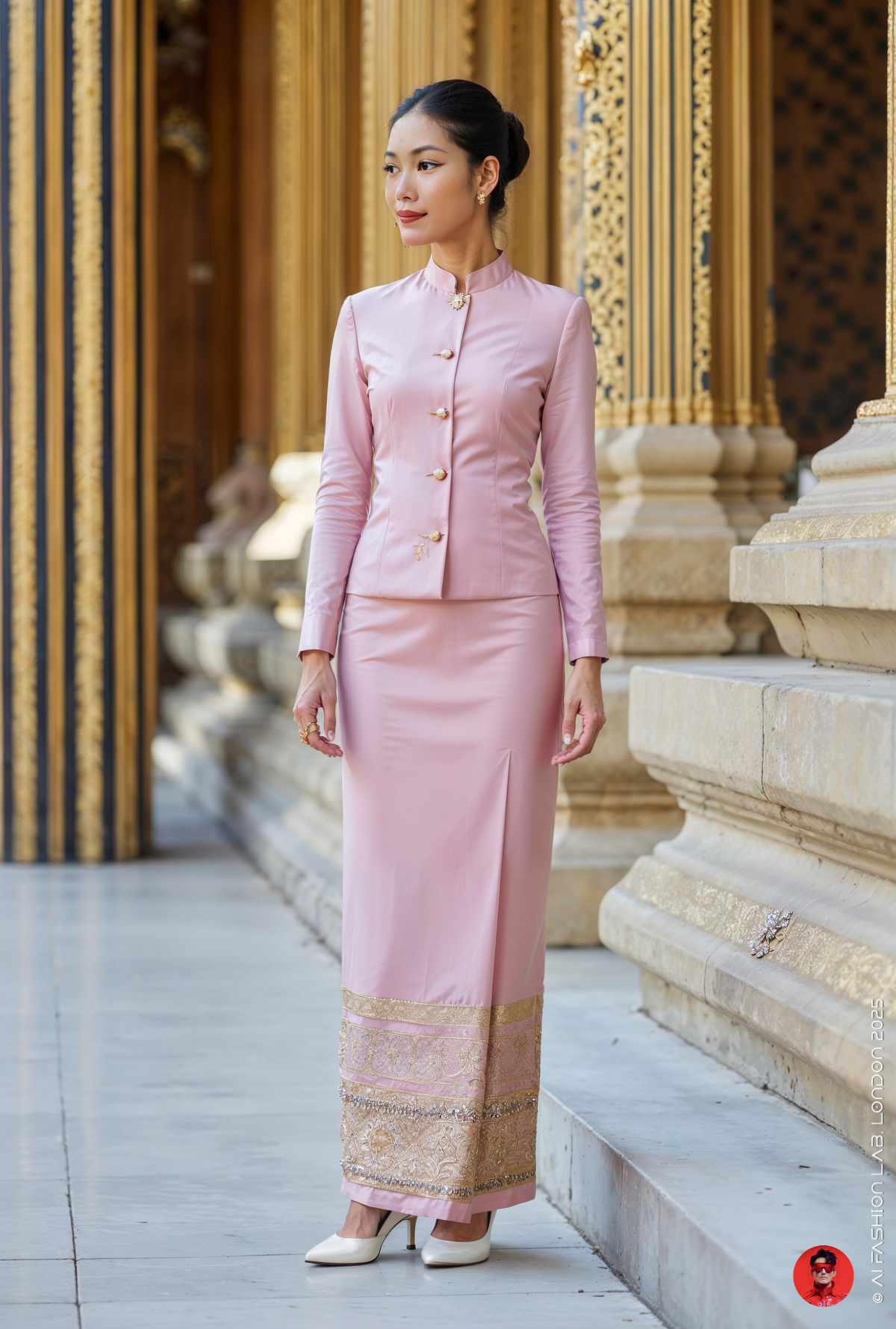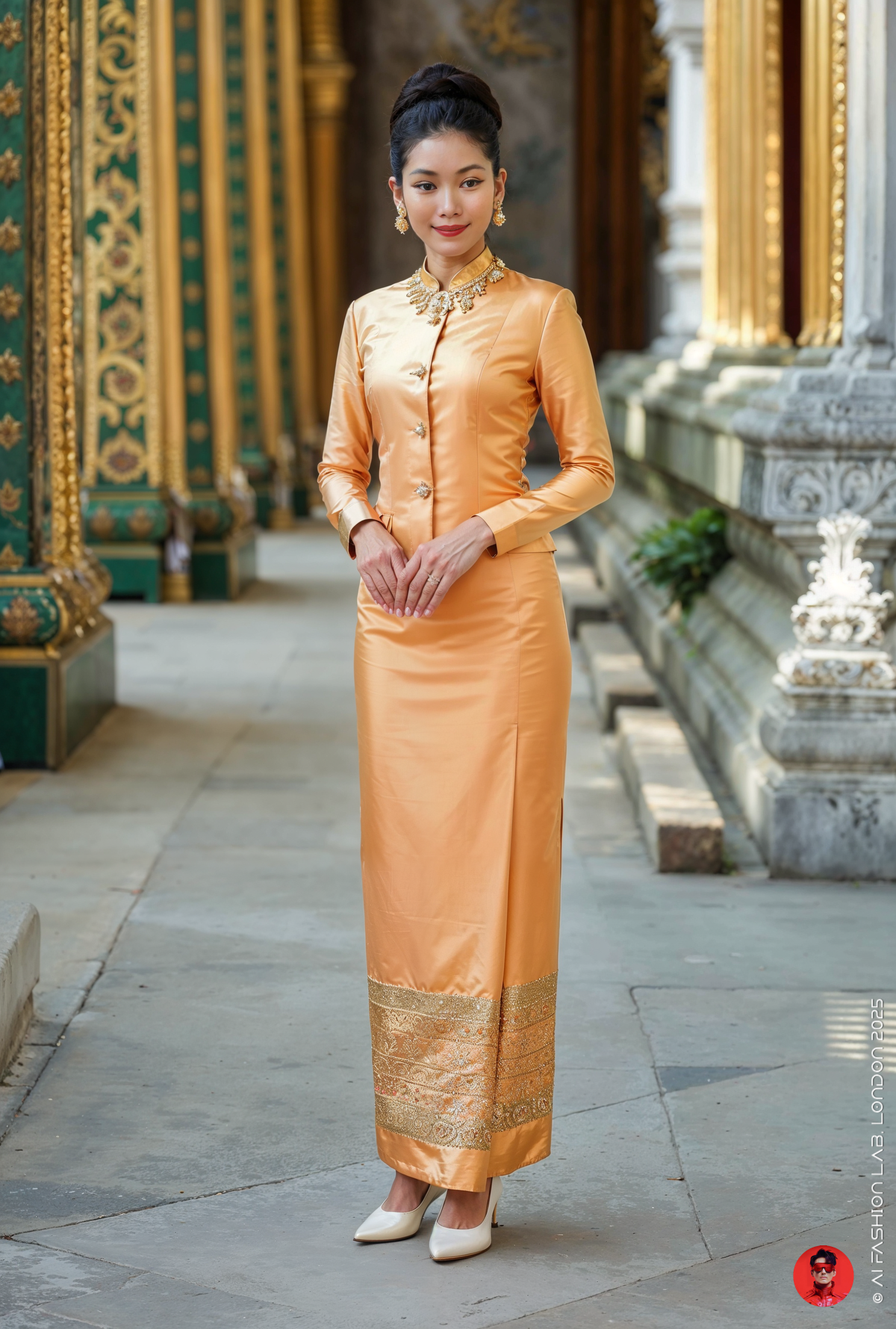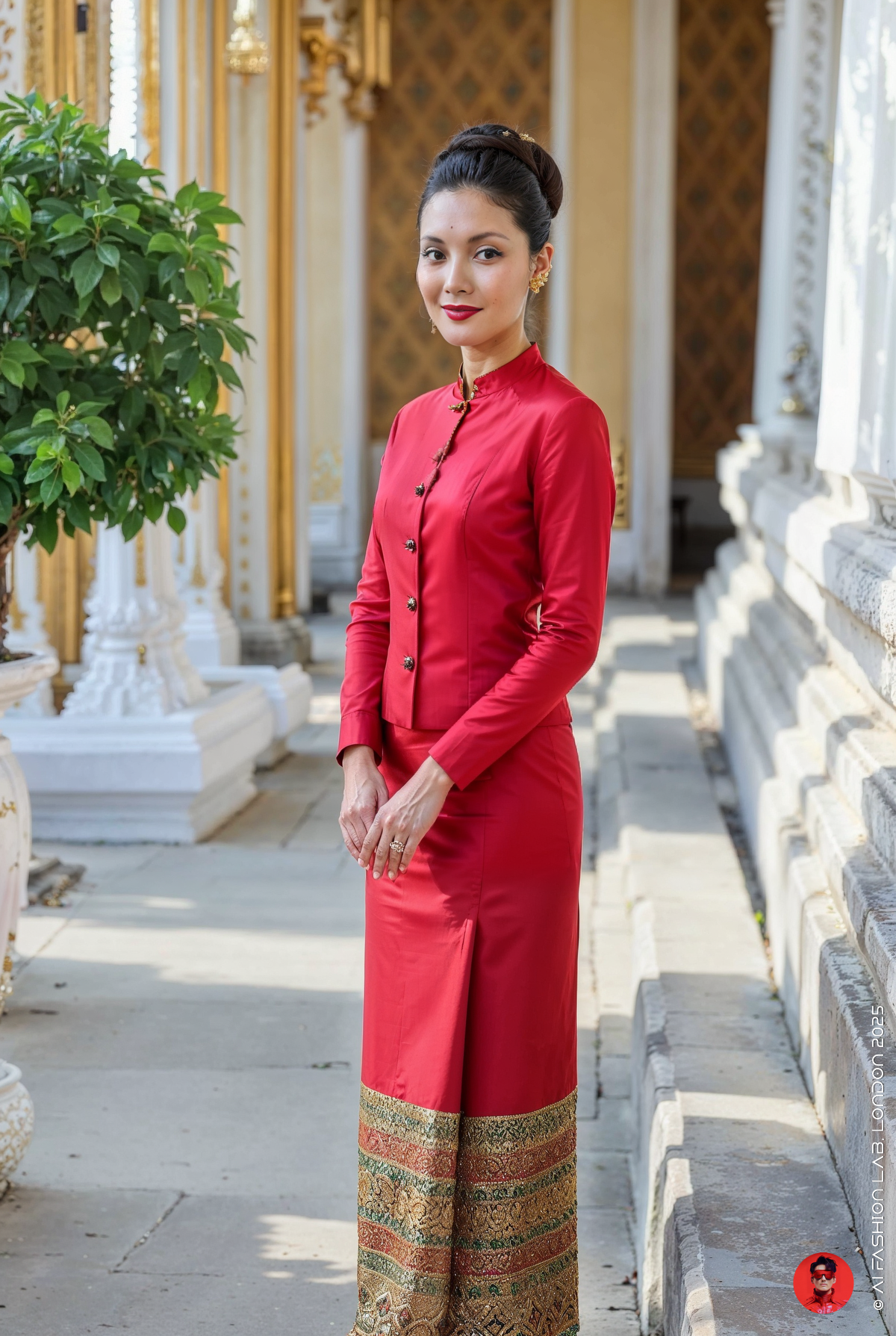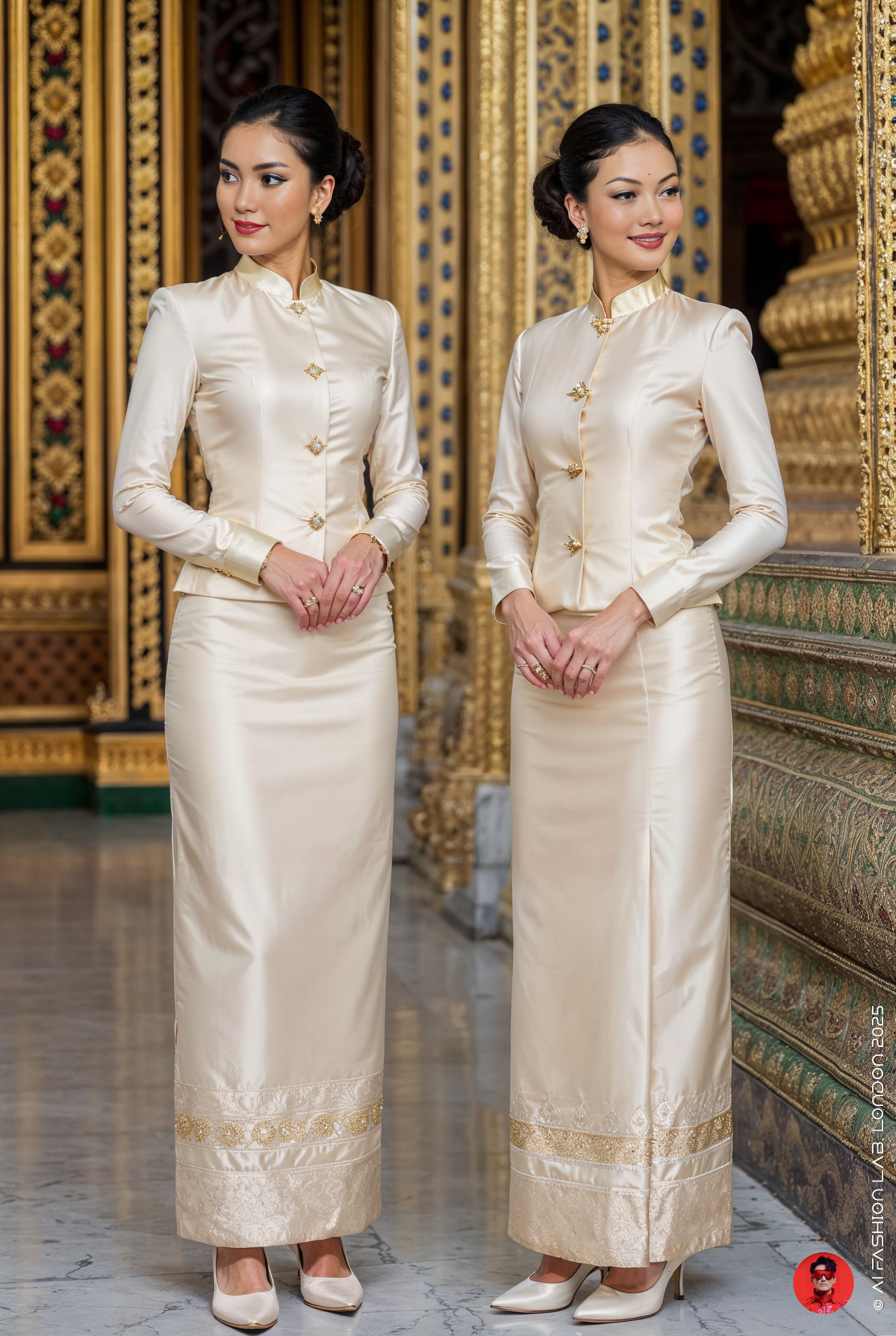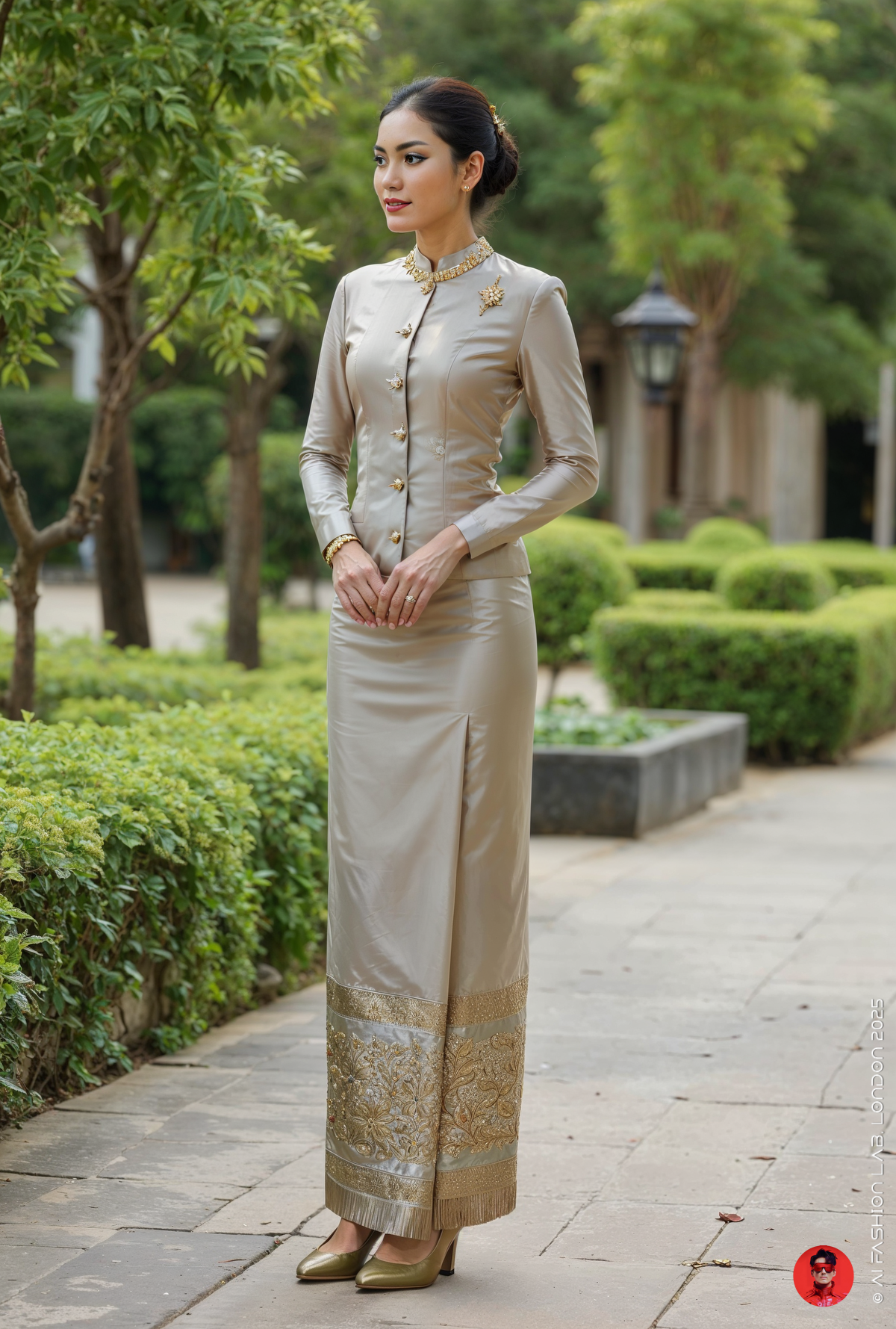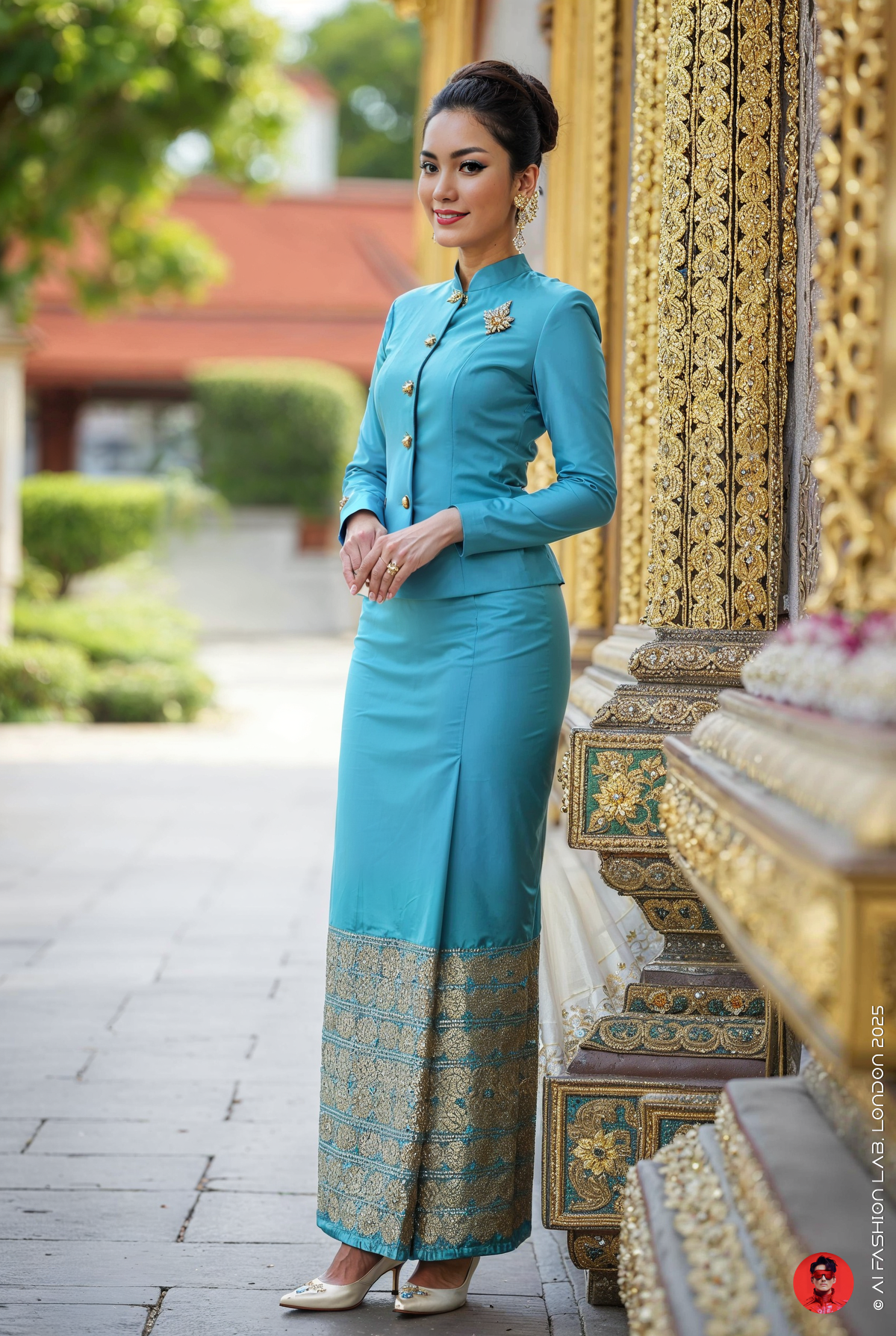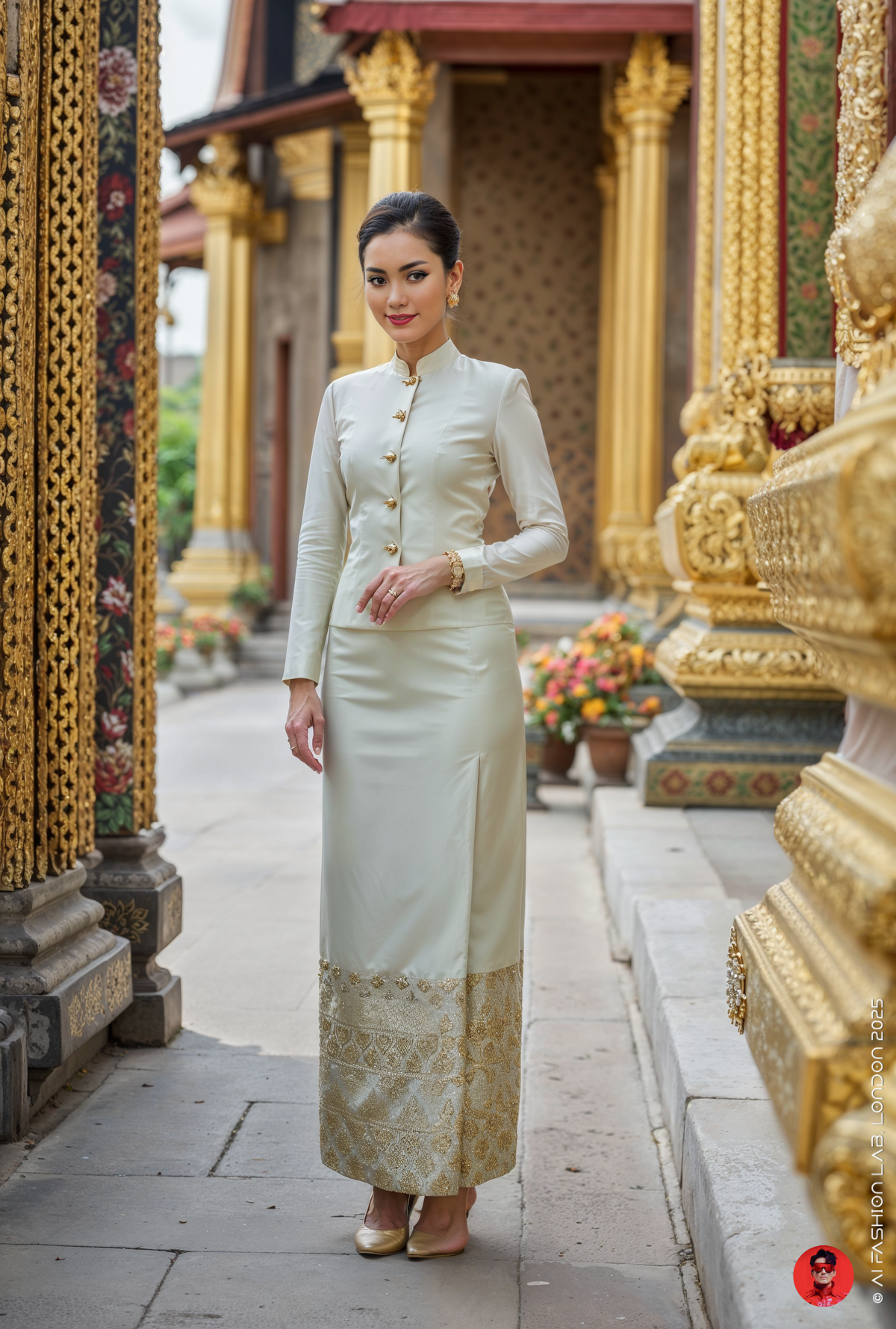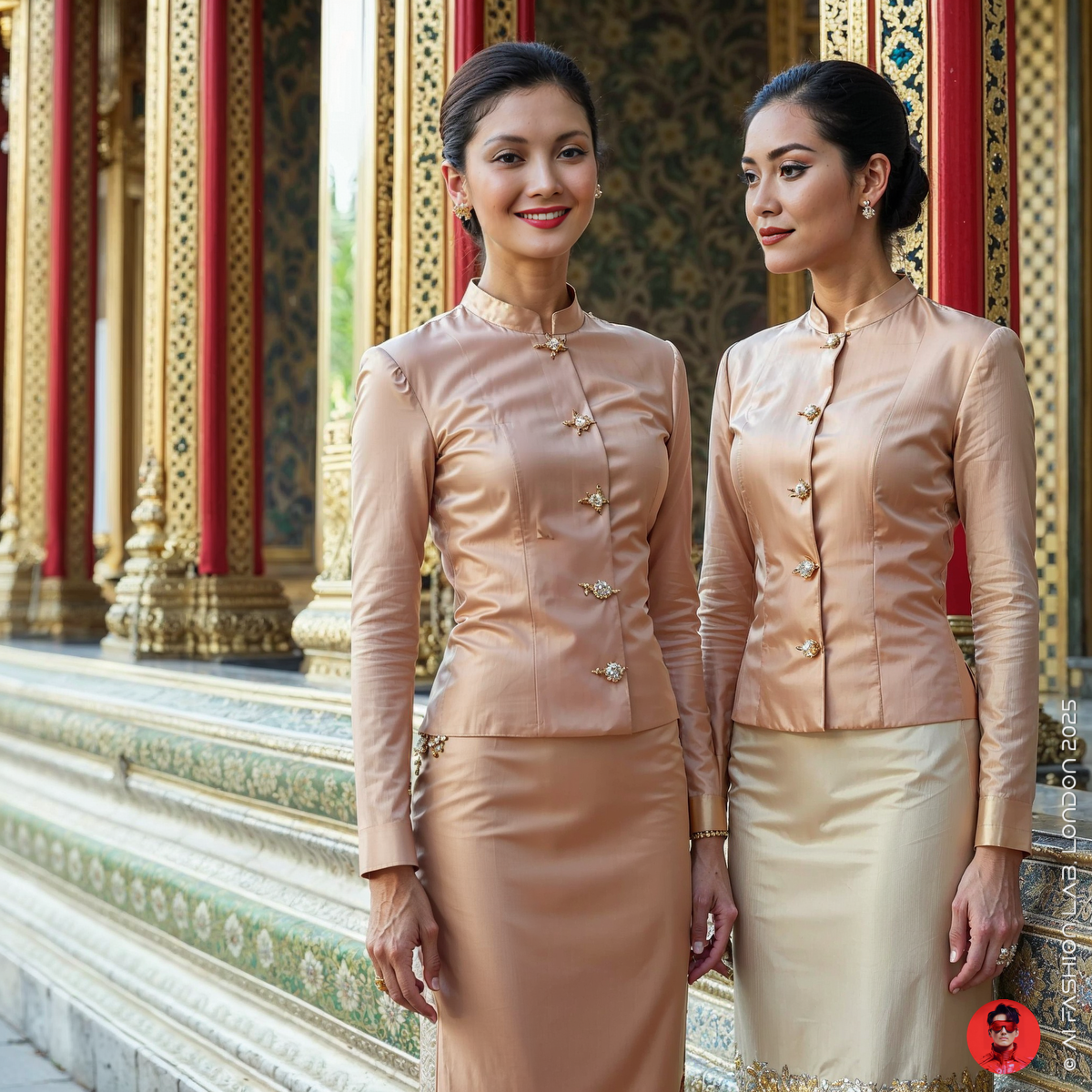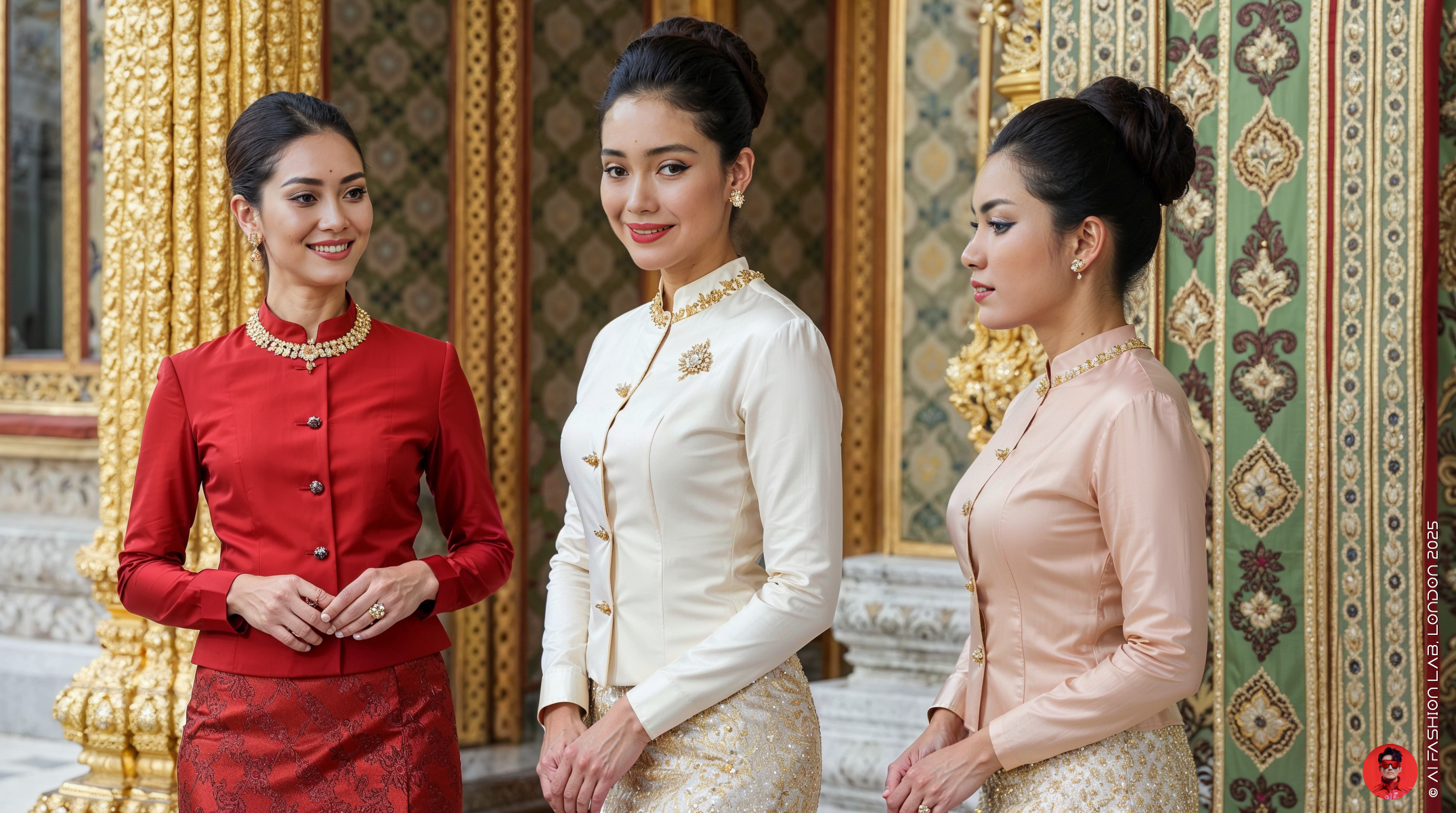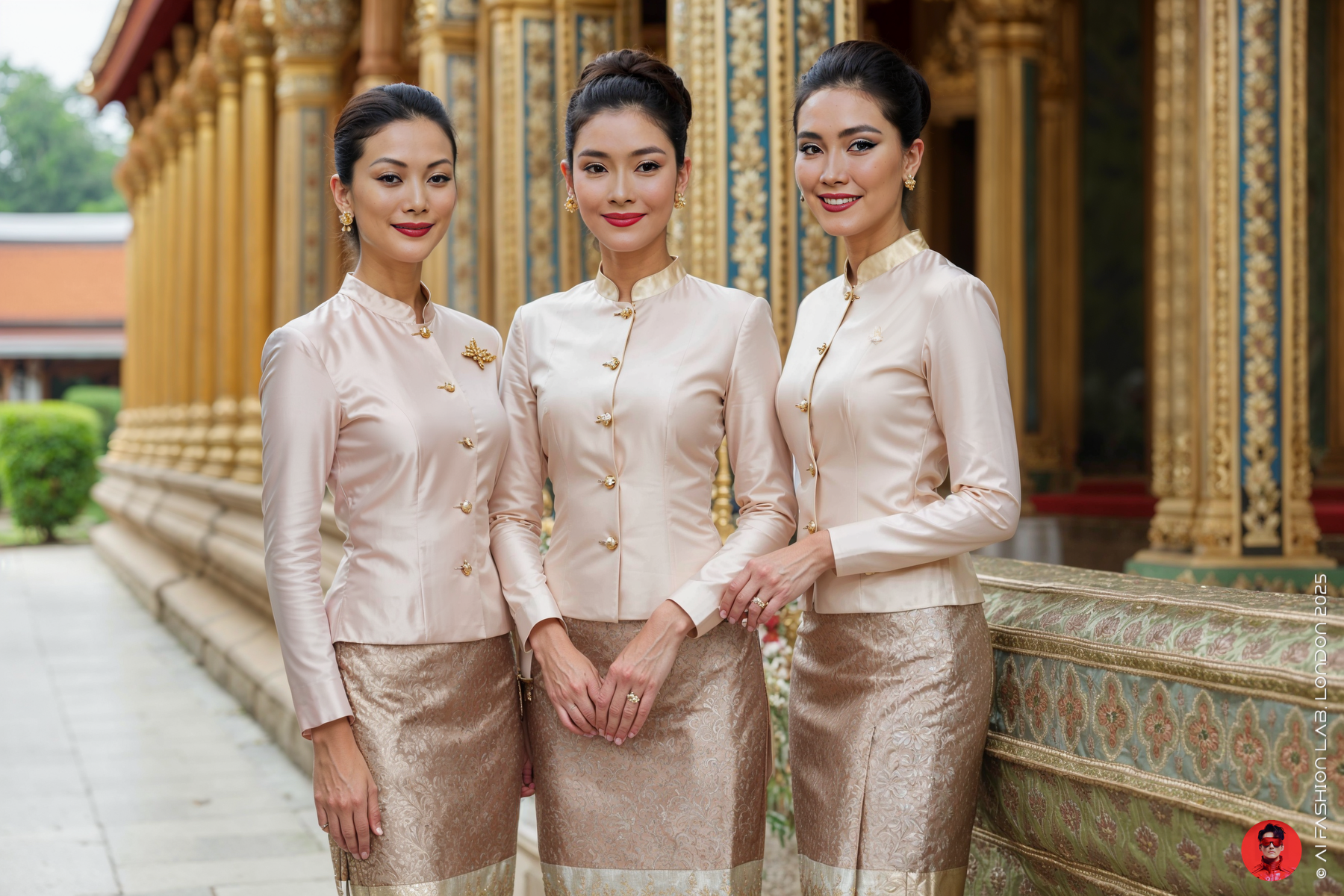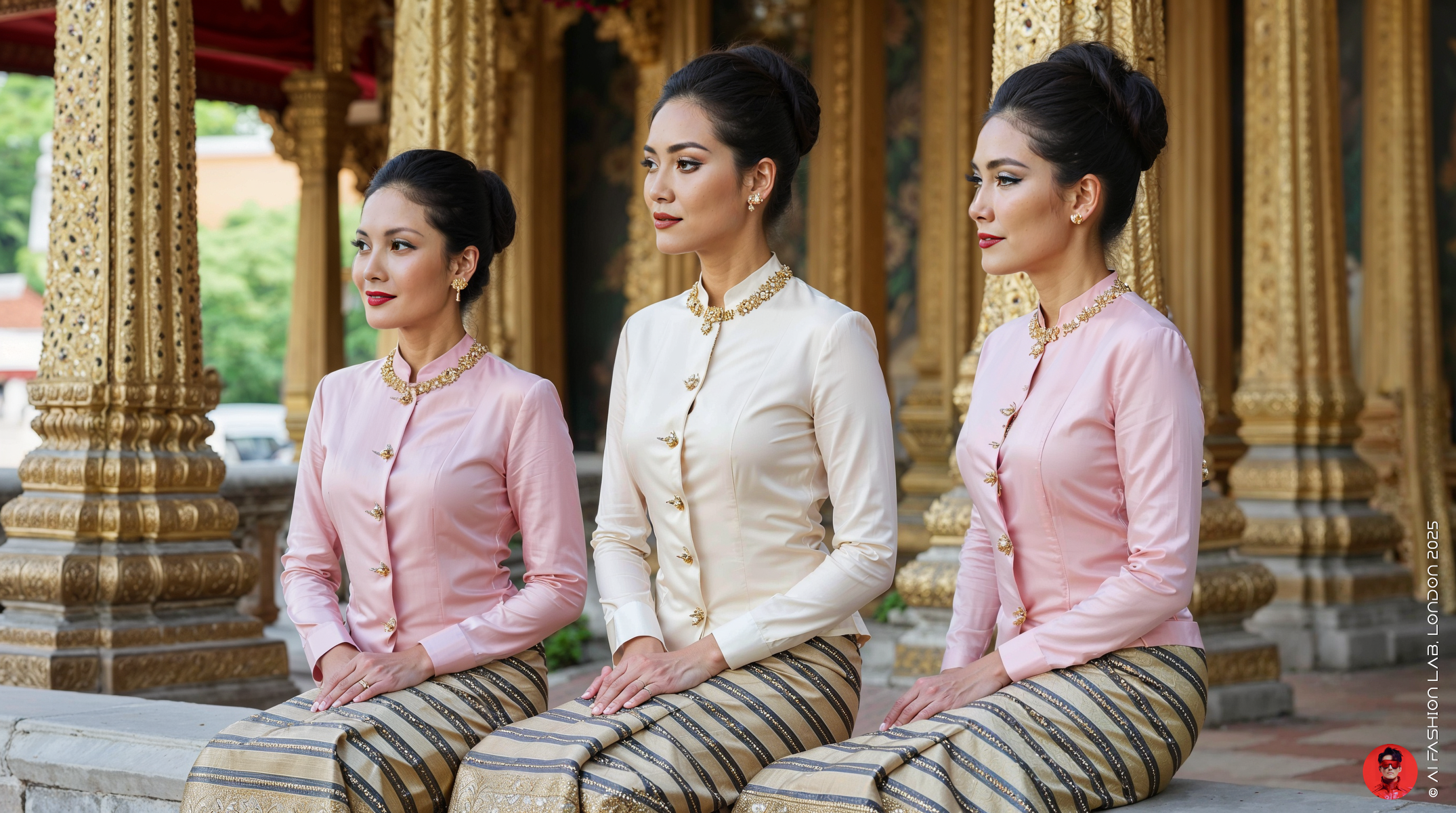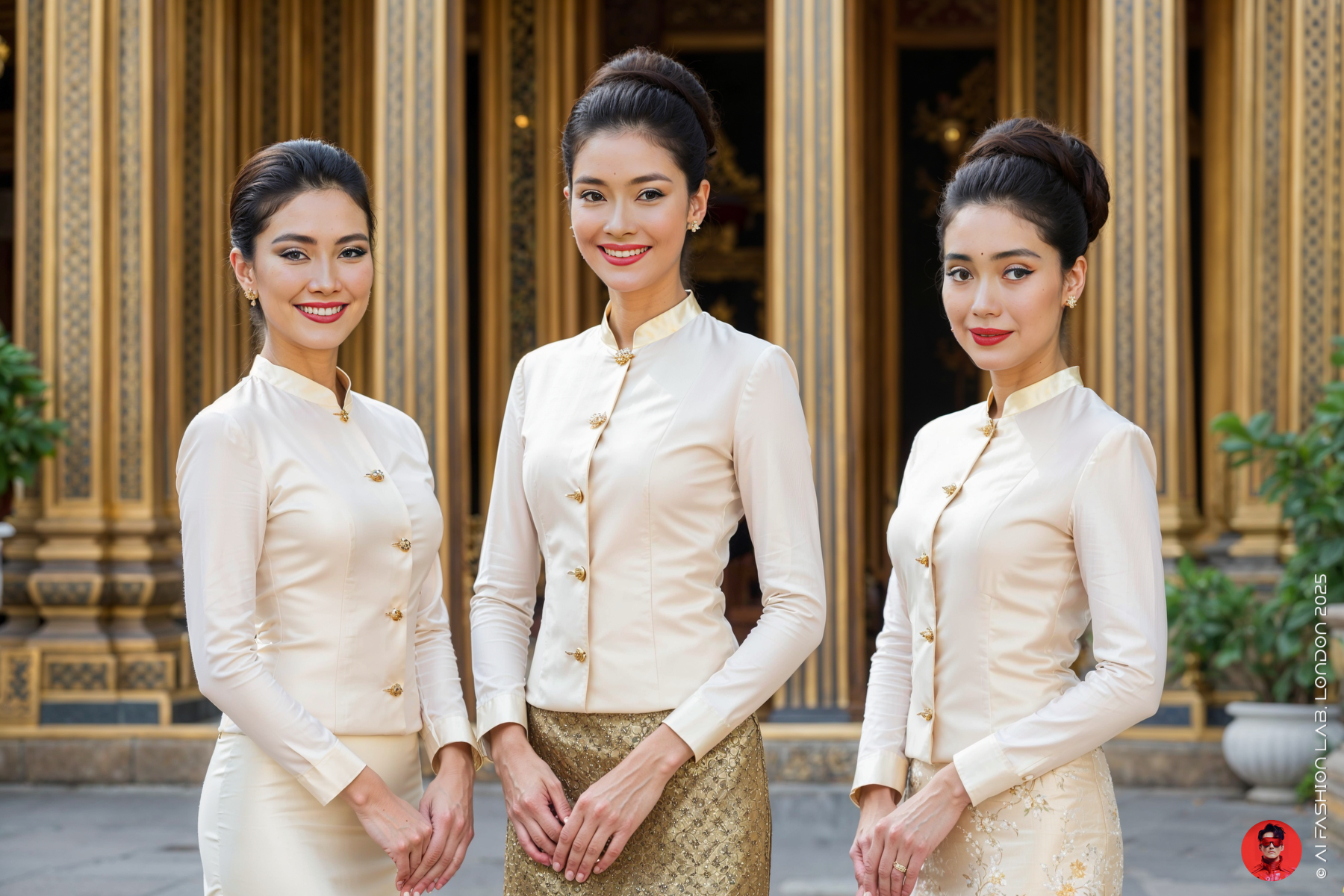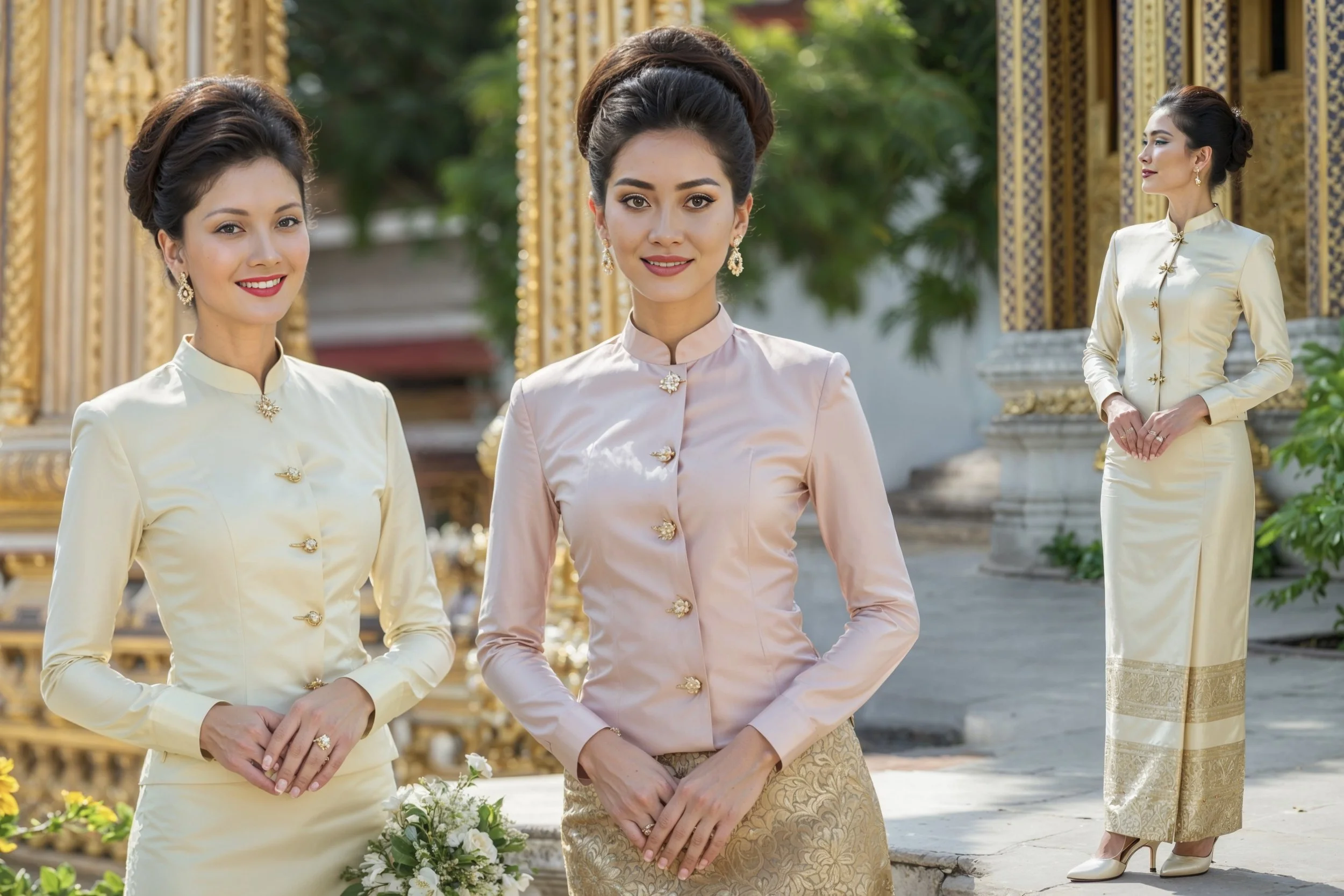ชุดไทยจิตรลดา ชุดไทยพระราชนิยม – เครื่องแต่งกายประจำชาติและความภาคภูมิใจในความเป็นไทย (๓ใน ๘)
ชุดไทยจิตรลดา ชุดไทยพระราชนิยม – เครื่องแต่งกายประจำชาติและความภาคภูมิใจในความเป็นไทย (ชุดแบบที่ 3 จากทั้งหมด 8 แบบในชุดไทยพระราชนิยม)
คอลเลกชันนี้เริ่มต้นจากการลงสีภาพถ่ายขาวดำต้นฉบับด้วย AI ซึ่งเป็นพระฉายาลักษณ์ของสมเด็จพระนางเจ้าสิริกิติ์ พระบรมราชินีนาถ พระบรมราชชนนีพันปีหลวง ขณะฉลองพระองค์ ชุดไทยจิตรลดา ซึ่งสันนิษฐานว่าเป็นภาพถ่ายจากช่วงปลายทศวรรษ 2500 ถึงต้นทศวรรษ 2510
ชุดไทยจิตรลดา นับเป็นชุดแบบที่ 3 ในบรรดาชุดไทยพระราชนิยมทั้ง 8 แบบ ออกแบบมาเพื่อสวมใส่ในงานพิธีช่วงเวลากลางวัน มีลักษณะสุภาพ เรียบหรู และแฝงไว้ด้วยความเป็นทางการ ตัวเสื้อทำจากผ้าไหมแขนยาว คอตั้งเล็กน้อยในแบบคอจีน เพื่อเสริมภาพลักษณ์อันสง่างามและเป็นทางการ แตกต่างจากชุดไทยเรือนต้นที่ใช้คอกลมต่ำและเหมาะกับโอกาสลำลอง
เสื้อทรงจิตรลดานี้นิยมสวมคู่กับ ผ้าซิ่นยาวคลุมข้อเท้า ซึ่งมักทอด้วยเทคนิค “ยกเชิง” โดยอาจเลือกใช้ผ้าพื้นสีเดียวกัน หรือผ้าต่างสีก็ได้ตามความเหมาะสม ชุดนี้เหมาะสำหรับพระราชพิธี หรือการต้อนรับอาคันตุกะจากต่างประเทศอย่างเป็นทางการ โดยไม่มีการประดับเครื่องราชอิสริยาภรณ์หรือเหรียญตราใด ๆ ดังเช่นในชุดไทยอัมรินทร์
ชุดไทยจิตรลดา เป็นการผสมผสานอย่างงดงามระหว่างความเรียบสง่าแบบไทยดั้งเดิมกับรสนิยมแบบสากลในยุค 1960 ได้อย่างกลมกลืน จึงนับเป็นต้นแบบที่เหมาะสมอย่างยิ่งสำหรับการรังสรรค์ด้วย AI ภายใต้แนวคิด “ความสง่างามแบบวินเทจสไตล์ไทย”
AI Collection ชุดนี้ได้รับแรงบันดาลใจจาก สมเด็จพระนางเจ้าสิริกิติ์ พระบรมราชินีนาถ พระบรมราชชนนีพันปีหลวง และ ชุดไทยพระราชนิยมทั้ง 8 แบบ ซึ่งทรงมีพระราชดำริจัดสร้างขึ้นระหว่างปี พ.ศ. 2503–2504 เพื่อให้สตรีไทยมีเครื่องแต่งกายที่สง่างาม สะท้อนเอกลักษณ์ของความเป็นไทย และเหมาะสมกับงานพิธีและโอกาสสำคัญต่าง ๆ
เพื่อเฉลิมพระเกียรติในพระราชดำริอันทรงคุณค่านี้ ผมจึงสร้างสรรค์ AI Collection ที่นำเสนอชุดไทยทั้ง 8 แบบผ่านมุมมองร่วมสมัย โดยผสมผสานกลิ่นอายแฟชั่นวินเทจแห่งยุค 1960s ซึ่งเป็นช่วงเวลาเดียวกับการกำเนิดของชุดเหล่านี้ ทั้งการจัดแสง ทรงผม และองค์ประกอบในภาพ ต่างได้รับการออกแบบอย่างประณีตเพื่อสะท้อนความงดงามของช่วงเวลาแห่งวัฒนธรรมไทยนี้อย่างสมบูรณ์
ในปีหน้า องค์การยูเนสโก (UNESCO) มีแนวโน้มจะขึ้นทะเบียน "ชุดไทยพระราชนิยม" เป็นมรดกภูมิปัญญาทางวัฒนธรรมของโลก โครงการนี้จึงมุ่งหวังที่จะเฉลิมฉลอง อนุรักษ์ และส่งต่อความภูมิใจในความเป็นไทยไปสู่คนรุ่นต่อไป
พระราชนิยมในการใช้ผ้าไทย: พระปณิธานของสมเด็จพระนางเจ้าฯ พระบรมราชินีนาถ
สมเด็จพระนางเจ้าฯ พระบรมราชินีนาถ ทรงมีพระราชนิยมในการใช้ ผ้าไทย มาตั้งแต่ยังทรงพระเยาว์ เมื่อครั้งสมเด็จพระเจ้าอยู่หัวมีพระราชดำริจะทรงประกาศหมั้น นักหนังสือพิมพ์ต่างประเทศได้ขอสัมภาษณ์พระองค์ ซึ่งพระองค์ทรงตอบอย่างชัดเจนว่า จะสนับสนุนและส่งเสริมการแต่งกายแบบไทย
ในโอกาสนั้น พระองค์ในฐานะ “พระคู่หมั้น” ทรงเลือกใช้ ผ้าไหมไทย และ ซิ่นไทย สำหรับชุดต่าง ๆ รวมถึง ฉลองพระองค์ในพระราชพิธีอภิเษกสมรส ก็ทรงใช้ผ้าไทยอย่างภาคภูมิ ภายหลังจากพระราชพิธีดังกล่าว พระองค์ทรงยึดมั่นในพระราชปณิธาน และทรงพระกรุณาโปรดให้สร้าง “เครื่องแต่งกายแบบไทยตามพระราชนิยม” ขึ้น จนกลายเป็น เครื่องแต่งกายประจำชาติของสตรีไทย มาจนถึงปัจจุบัน
ในสมัยที่เสด็จฯ เยือนประเทศเพื่อนบ้านเป็นครั้งแรก ยังไม่มีการกำหนดชุดไทยตามแบบพระราชนิยม พระองค์จึงทรงริเริ่มออกแบบฉลองพระองค์โดยใช้ ผ้าไหมไทย ผ้ายก และผ้าพื้นถิ่นไทย ต่าง ๆ มาตัดเย็บและประดิษฐ์ตกแต่ง เพื่อให้สื่อถึงอัตลักษณ์ของความเป็นไทย โดยทรงเจริญรอยตามสมเด็จพระพันปีหลวง สมเด็จพระศรีพัชรินทรา บรมราชินีนาถ
ชุดไทยพระราชนิยม
“ชุดไทยพระราชนิยม” หมายถึง ชุดแต่งกายประจำชาติของสตรีไทยที่ใช้ในงานพิธี งานมงคลสมรส และโอกาสสำคัญต่าง ๆ ชุดเหล่านี้มีลักษณะเฉพาะทางด้านรูปแบบ วัสดุ และการตกแต่ง โดยนิยมใช้ผ้าไหม ผ้าฝ้าย หรือผ้าใยประดิษฐ์ เช่น ผ้าพื้น ผ้าลายดอก ผ้าลายริ้ว ผ้ายกดิ้นเงิน ดิ้นทอง หรือผ้ายกดอกทั้งผืน พร้อมตกแต่งด้วยซิป ตะขอ หรือกระดุมที่หุ้มด้วยผ้า และอาจปักมุก เลื่อม หรือใช้ลูกปัดตกแต่งเพื่อเพิ่มความสง่างาม
ประเภทผ้าที่นิยมใช้ เช่น:
ผ้าไหม: ทอจากเส้นด้ายที่ได้จากใยไหม
ผ้าฝ้าย: ทอจากเส้นด้ายฝ้ายธรรมชาติ
ผ้าใยประดิษฐ์: ผ้าใยสังเคราะห์ เช่น โพลีเอสเตอร์ เรยอน เจอร์ซีย์ หรือโทเร
ชุดไทยพระราชนิยมทั้ง 8 แบบ ได้แก่
ชุดไทยเรือนต้น – เรียบง่าย เหมาะสำหรับงานไม่เป็นทางการหรือสวมใส่ในชีวิตประจำวัน
ชุดไทยจิตรลดา – สุภาพ เหมาะสำหรับงานพิธีการเล็กน้อยหรือรับรองแขก
ชุดไทยอมรินทร์ – งดงาม เหมาะกับงานราตรีหรืองานพิธีสำคัญ
ชุดไทยบรมพิมาน – ผ้าไหมลายสวย ใช้ในงานพิธีการและงานทางการ
ชุดไทยจักรี – หรูหรา สง่างาม เหมาะกับงานพิธีระดับสูง
ชุดไทยดุสิต – ใช้ผ้าไหมลวดลาย ปักลายวิจิตร สำหรับงานราตรีหรืองานฉลอง
ชุดไทยศิวาลัย – หรูหรา เน้นเครื่องประดับ ใช้ในงานพิธีสำคัญ
ชุดไทยจักรพรรดิ์ – สง่างามที่สุด ใช้ในงานพิธีใหญ่ระดับราชสำนัก
Chut Thai Chitralada (ชุดไทยจิตรลดา) – A Symbol of National Attire and Thai Pride (3 of 8 Styles)
This collection began with the colourisation of an original black-and-white photograph using AI. The image features Her Majesty Queen Sirikit The Queen Mother wearing Chut Thai Chitralada (ชุดไทยจิตรลดา), which is believed to date from the late 1950s to early 1960s.
Chut Thai Chitralada (ชุดไทยจิตรลดา) is the third style among the eight forms of Thai national dress, designed for formal daytime functions. It is graceful, understated, and dignified. The blouse is made of silk with long sleeves and a slightly raised Mandarin-style collar, lending a formal appearance. This contrasts with Chut Thai Ruean Ton, which has a round, lower neckline and is intended for informal occasions.
The Chitralada-style blouse is worn with a long ankle-length tubular skirt (sinh), often woven with a decorative hem in the yok cheng technique. The skirt may be of the same colour or in a complementary tone. This ensemble is appropriate for royal ceremonies or for welcoming foreign dignitaries in a formal setting and is typically worn without royal insignia or medals, unlike Chut Thai Amarin.
Chut Thai Chitralada (ชุดไทยจิตรลดา) beautifully blends traditional Thai aesthetics with the global fashion influences of the 1960s. Its timeless elegance makes it especially well-suited for creative reinterpretation through AI under the concept of “Vintage Thai Elegance.”
This AI Collection draws inspiration from Her Majesty Queen Sirikit The Queen Mother and the full series of eight Chut Thai Phra Ratcha Niyom (ชุดไทยพระราชนิยม), which were developed under her royal initiative between 1960 and 1961. The goal was to create refined and graceful national attire for Thai women—garments that reflect Thai cultural identity and are appropriate for ceremonial functions and state occasions.
To honour this visionary royal initiative, I have created an AI Collection that reimagines all eight styles through a contemporary perspective. Each image is infused with the charm of 1960s vintage fashion—the era in which these national dresses first emerged. Lighting, hairstyle, and composition have all been meticulously crafted to convey the beauty of this cultural moment in Thai history.
Royal Patronage of Thai Textiles: Her Majesty’s Lifelong Commitment
Her Majesty Queen Sirikit The Queen Mother has embraced Thai textiles since her youth. When His Majesty King Bhumibol Adulyadej (Rama IX) intended to announce their engagement, foreign journalists interviewed Her Majesty, who expressed her firm commitment to promoting Thai dress.
At the time, as the royal fiancée, she chose to wear Thai silk and traditional Thai sinh in various ensembles. Notably, she wore Thai fabrics with pride during the Royal Wedding Ceremony. After the ceremony, Her Majesty continued to champion Thai textiles, graciously initiating the creation of the Chut Thai Phra Ratcha Niyom (ชุดไทยพระราชนิยม)—a series of formal national dresses for Thai women, now recognised as part of Thailand’s cultural identity.
During her first state visits to neighbouring countries, when no official Thai national dress had yet been established, Her Majesty began designing her formal attire using Thai silk, brocade, and regional Thai textiles. These designs reflected the essence of Thai identity and followed in the footsteps of Queen Saovabha Phongsri (Queen Sri Bajarindra), consort of King Chulalongkorn (Rama V), who had once served as Queen Regent.
Chut Thai Phra Ratcha Niyom (ชุดไทยพระราชนิยม)
Chut Thai Phra Ratcha Niyom refers to the formalised series of Thai national dresses for women, used in ceremonies, weddings, and official events. These garments are characterised by specific patterns, fabrics, and decorative details. Common materials include silk, cotton, and synthetic fibres, in plain colours, floral prints, stripes, or intricately woven patterns using metallic threads. Decorations may include fabric-covered buttons, zippers, or hooks, and sometimes delicate embellishments such as pearls, sequins, or beadwork.
Common fabrics used:
Thai silk – woven from natural silk fibres
Cotton – made from natural cotton threads
Synthetic fibres – such as polyester, rayon, jersey, or Toray
The Eight Styles of Chut Thai Phra Ratcha Niyom (ชุดไทยพระราชนิยม):
Chut Thai Ruean Ton (ชุดไทยเรือนต้น) – Simple, ideal for informal or everyday wear
Chut Thai Chitralada (ชุดไทยจิตรลดา) – Modest, suitable for semi-formal events or diplomatic receptions
Chut Thai Amarin (ชุดไทยอมรินทร์) – Elegant, appropriate for evening functions or formal ceremonies
Chut Thai Boromphiman (ชุดไทยบรมพิมาน) – Refined, typically made of patterned silk for ceremonial use
Chut Thai Chakri (ชุดไทยจักรี) – Luxurious and stately, ideal for high-level royal functions
Chut Thai Dusit (ชุดไทยดุสิต) – Decorated with intricate patterns, suitable for gala dinners or celebrations
Chut Thai Siwalai (ชุดไทยศิวาลัย) – Ornate and jewel-accented, designed for important royal ceremonies
Chut Thai Chakkraphat (ชุดไทยจักรพรรดิ์) – The most majestic, reserved for grand palace occasions
#aifashionlab #AI #aiartist #aiart #aifashion #aifashiondesign #aifashionstyling #aifashiondesigner #fashion #fashionhistory #historyoffashion #fashionstyling #fashionphotography #digitalfashion #digitalfashiondesign #digitalcostumedesign #digitaldesign #digitalaiart #ThaiFashionHistory #ThaiFashionAI





